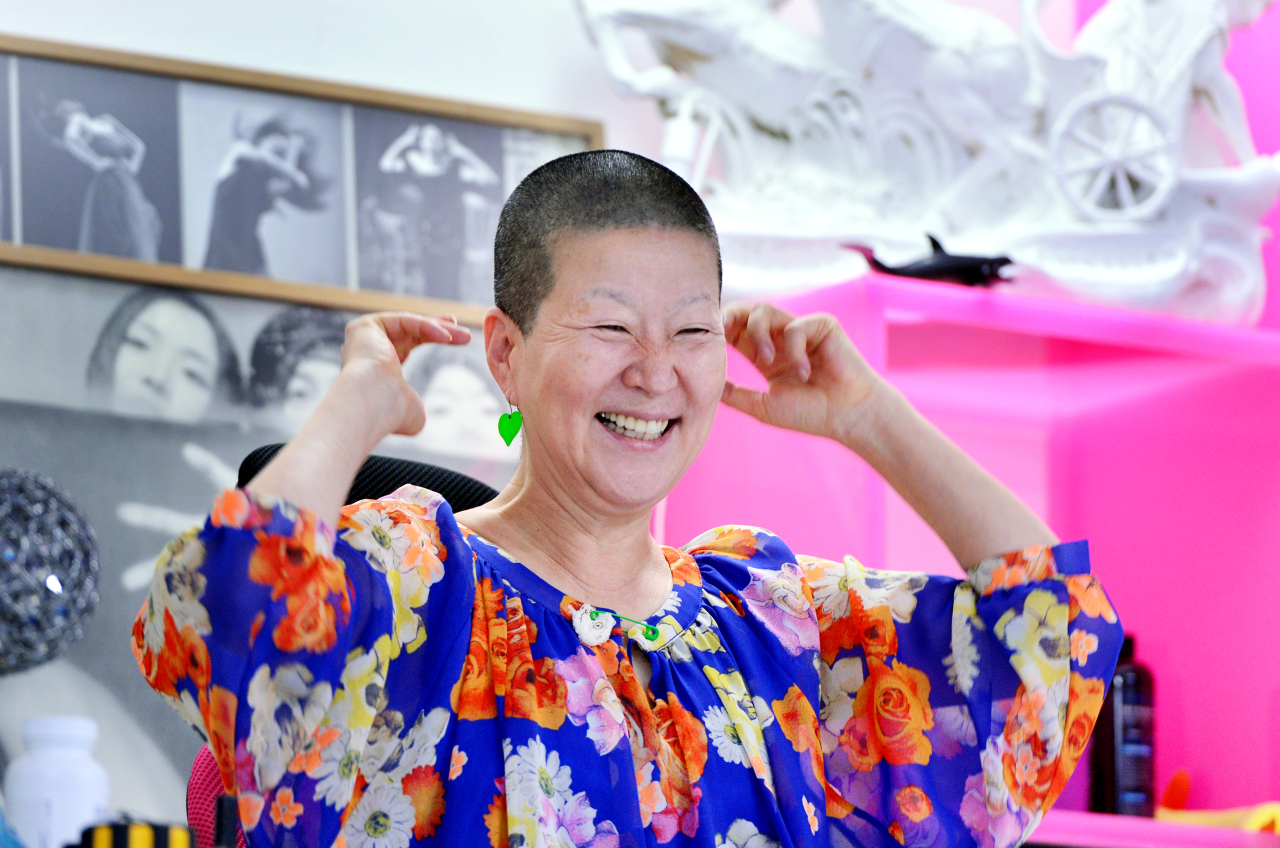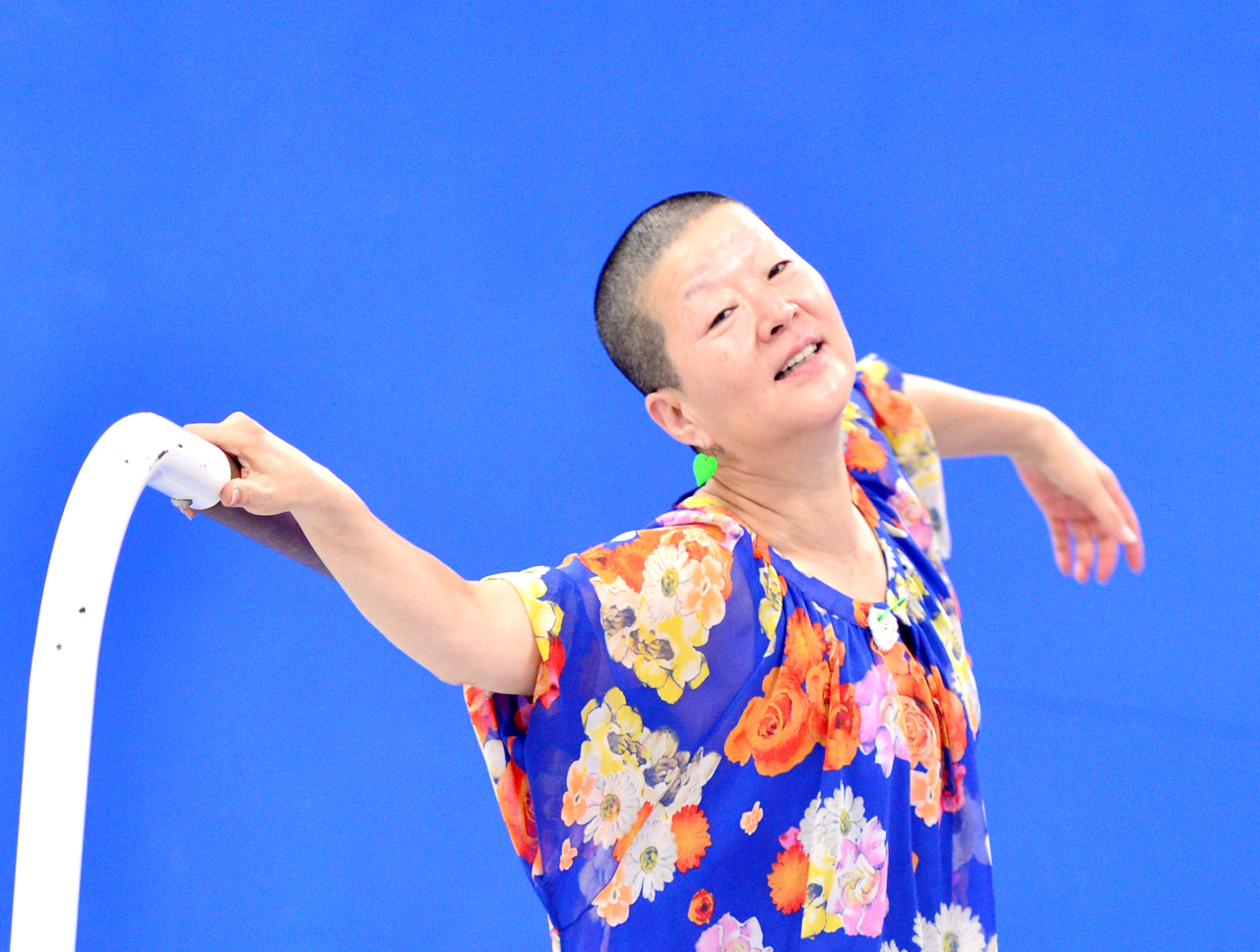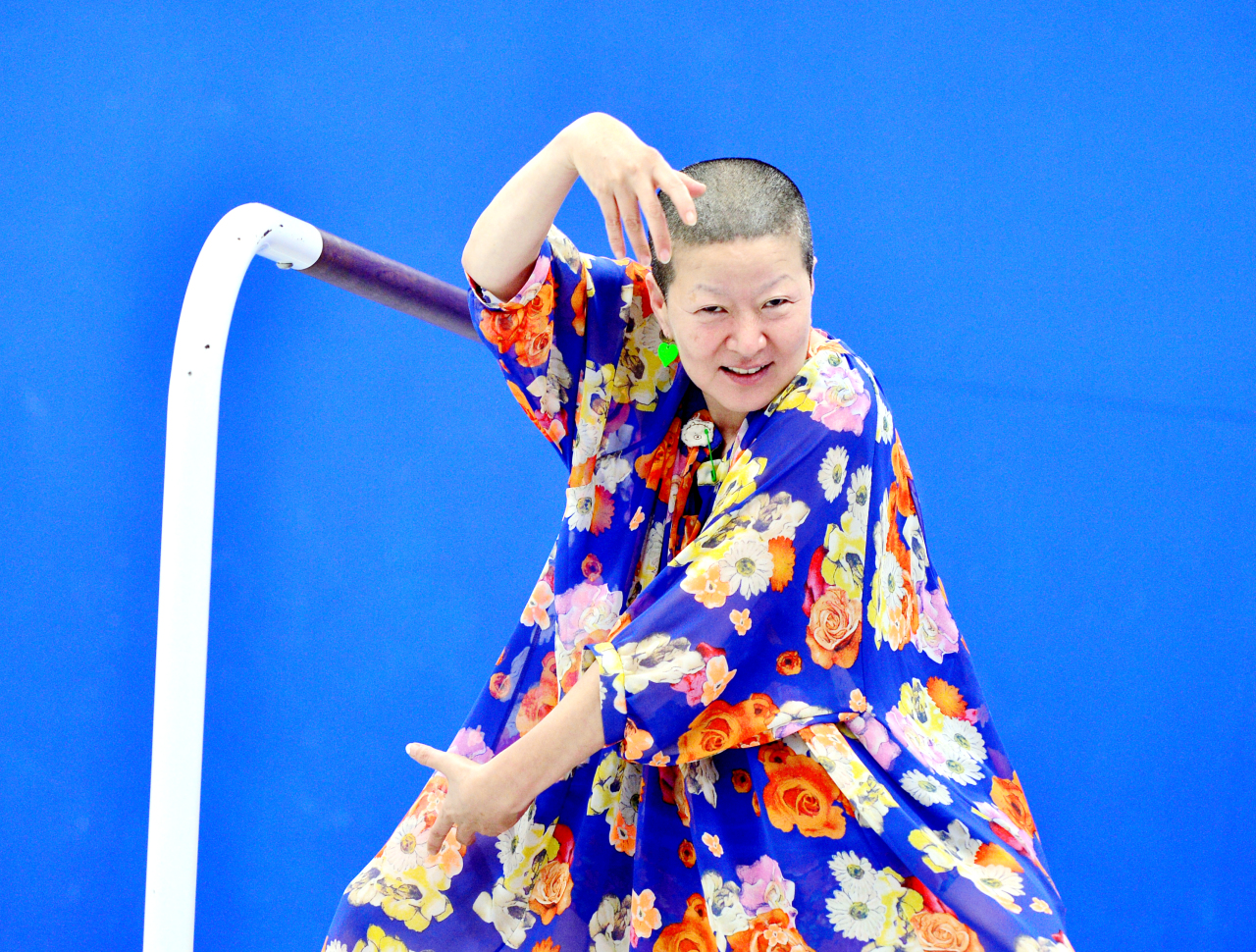 |
Choreographer Ahn Eun-me poses at her studio in Hannam-dong, Seoul, Aug. 18. (Park Hyun-koo/The Korea Herald) |
When I enter choreographer Ahn Eun-me’s studio located in the basement of a building that houses a gas station on the ground level, she is perched on a balcony with a commanding view of the studio from which she presides over her eponymous dance company, Ahn Eun-Me Company.
She is hard to miss: Ahn’s buzz cut renders her instantly recognizable.
“Long hair was restrictive and the head gets too heavy,” says Ahn, explaining her decision to shave it all off in September 1991. How many people remember the precise time when they cut their hair? The fact that she remembers it nearly 30 years on speaks volumes about its significance.
She had been agonizing over it for five years when she told herself, “I won’t be able to do it if I put it off for too long.”
It wasn’t something that made sense to most people at the time, she admits, but she felt she had found the style that suited her best. “It felt as if there was this white light shining from me,” she says.
It also taught her something about life. “I realized that it takes a very long time to realize the things that you desire in life,” she says. “And that courage gave me many answers to life’s questions,” she says.
When I comment that she looks like someone who can do anything she wants to do, Ahn, who appears self-assured and fearless, makes one exception. “At 30, I realized I wasn’t fit for marriage,” she says, adding, with a laugh, “No one has approached me since I shaved my head.”
It would perhaps be truer to say that she had neither the time nor the energy necessary for a marriage, which would not come as a surprise from someone who professes to not have the time to fiddle with hair. Indeed, she says she spends all her energy on teaching her young colleagues.
 |
Choreographer Ahn Eun-me (Park Hyun-koo/The Korea Herald) |
Pandemic offers new vision
She is dressed in a breezy, colorful dress that floats with her as she poses for photos against a blue wall. When I comment on how perfect the dress looks against the wall, she says, “I chose it precisely for that effect!”
Her entire person exudes the vibrancy of the bright colors she is so fond of wearing. She moves with much energy and her voice, while not loud, is powerful. Yet when she is instructing her dancers, she employs an almost childlike inflection.
Like so many people around the world, Ahn has had her life and work disrupted by the COVID-19 pandemic. The Ahn Eun-Me Company was in middle of a three-month European tour when performances were abruptly canceled.
The company had been performing “North Korea Dance,” Ahn’s interpretation of the dance of North Korea, in Europe since January when the novel coronavirus situation on the continent suddenly reached a crisis point. “By then, we had performed in Belgium, France, Switzerland and Turkey. It was to have been our longest tour. It took two years to realize,” says Ahn with a hint of wistfulness.
The team of 11 dancers was stuck at a home in France for two weeks, during which time they all became very good cooks, according to Ahn. After several postponements, waiting for the theaters to reopen, Ahn decided to pack up and head back home.
The situation back home at the end of March was not as dire as it had been in Europe, and, with her usual optimism and vigor, Ahn set about looking for ways to work around the pandemic. Fortuitously, she heard that the Seoul Foundation for Arts and Culture was accepting applications for emergency funding. She applied and received 19 million won ($16,022), which she used to create “1’ 59” around the world,” an online version of the “1’ 59” Project.”
Premiered in Paris in the summer of 2014, “1’ 59” Project” is a program that aims to get ordinary people onstage. The participants create and perform their own pieces that are 1 minute and 59 seconds in duration. In ordinary times, it would be held in a different country each year. This year, it was set to be held in Germany.
Since there was no possibility of a physical gathering, Ahn cast a wider net, inviting people from all around the world, regardless of country of origin, gender or age, to participate in a “lesson in movement.”
Some 40 people from 10 countries were selected on a first-come, first-served basis and were coached via Zoom without any touching or directions. “We said, ‘We would like to make it possible for you to do what you want to do. We want to be inspired by you,’” Ahn recalls.
Instead of being performed onstage, the final pieces produced by the participants were released Aug. 7 on YouTube. “The participants also edited the videos, learning how to do it on their own, teaching and learning from each other,” Ahn says.
The veteran choreographer as blown away by the final product and believes she has witnessed how the virtual space encourages greater creativity than is afforded by the stage. “People revealed their desires,” Ahn says, noting how they had all been confined to their homes for weeks or months due to the coronavirus. “(For the participants) It brought about a change in life,” she says.
For Ahn, the project presented a new vision, one in which a global network would play a prominent role. The coronavirus, which has forced people to withdraw into their homes, their close groups, has opened a whole new, wider world for Ahn.
 |
Choreographer Ahn Eun-me (Park Hyun-koo/The Korea Herald) |
Getting people to move Ahn began dancing at the age of 5, spurred on by the sight of colors she had never seen before. What she had seen at a marketplace all those years ago was a group of dancers, clad in colorful costumes, on their way to a dance school. She asked her mother if she could get lessons, was refused, but found a way.
Ahn trained in traditional Korean dance -- ballet was not widespread in Korea at the time -- before moving on to modern dance. Unlike ballet, where specific physical attributes are required, such as long, lean limbs, modern dance seeks diverse physical types, according to Ahn. “All people are equal” in modern dance but ballet centers around the prima donnas, she notes.
Modern dance also has no fixed ideas and it can be performed outside performance venues. To mark her 30th anniversary as a dancer, Ahn held a “retrospective” at the Seoul Museum of Art last year. In fact, many of her works feel like performance art and non-dance conceptual art, in Ahn’s own words. “My experimentation confirmed that there are things that are lost when we focus on form and style,” she says.
Ahn is known for getting ordinary people to get up and dance, or perhaps more precisely, move their bodies any which way they desire. How does she do it, especially in Korea, where dance suffers from an unsavory image? Dancing, or “chum,” is often associated with “chumbaram,” a word frequently used to describe a fling.
“I tell them to keep their eyes closed if they feel shaky, nervous. If you stand still, your body’s memory is aroused,” she says. “I ask them to ask themselves what it is that they are afraid of,” she continues. “When they learn to move, they change in a positive way,” she says. “When people dance, they all laugh!”
What does dance mean for Ahn, who seems to live and breathe her art?
“Dance, for me, is a house that I have to live in and carry on my back. It is a conversation that one can have with the self. It is another form of prayer, an execution of which releases dopamine. We live forgetting this,” Ahn says without pausing for a breath. “Dance is a very important emotional and physical tool,” she says.
Observing that today’s youngsters live in a virtual world, Ahn says they will have very different thoughts. “The language of the physical body is very important. There is a very big difference between people who have experienced this and those who have not experienced it,” says Ahn. “We all need the time to freely express what we wish to express.
By Kim Hoo-ran (
journalist@heraldcorp.com)










![[Today’s K-pop] Blackpink’s Jennie, Lisa invited to Coachella as solo acts](http://res.heraldm.com/phpwas/restmb_idxmake.php?idx=644&simg=/content/image/2024/11/21/20241121050099_0.jpg)